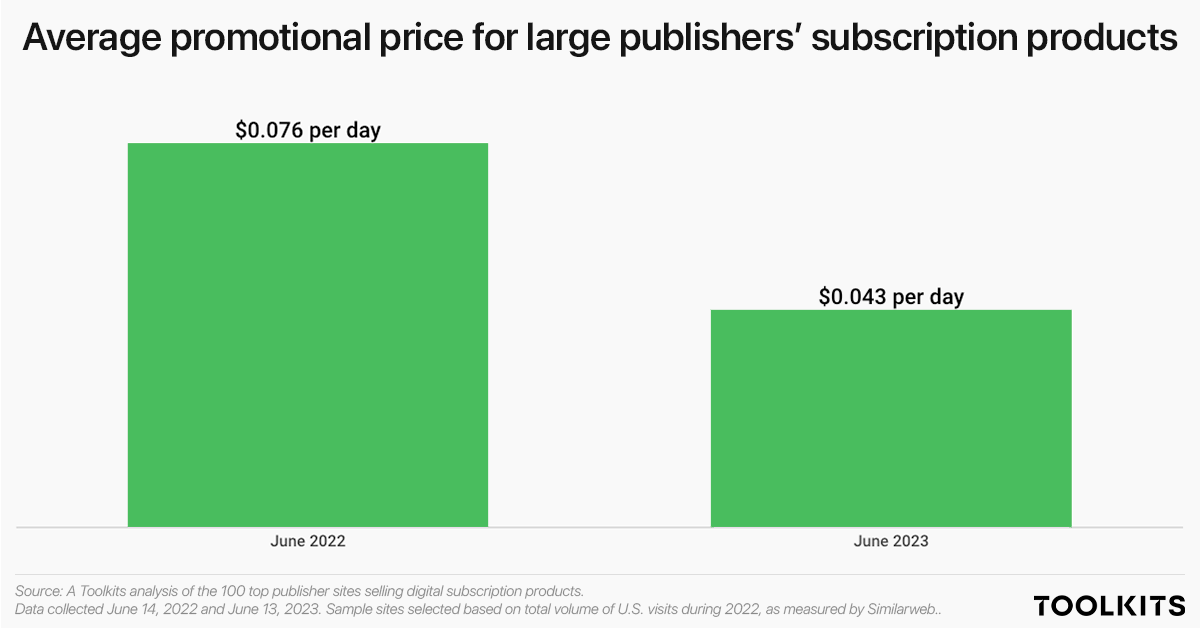More than 80% of large news publishers offer readers promotional subscription prices (think “$1 for one month”) as a way to reel in subscribers who will, hopefully, stick around when the promotion is over. The prices of those trials have fallen by nearly 50%, according to new research from media company Toolkits.
Toolkits looked at the top 100 publishers that offer monthly or 4-week digital subscription products, comparing their promotional pricing between June 14, 2022, and June 13, 2023. The publications were selected based on website data from SimilarWeb.
Toolkits found that promotional pricing has decreased by 43.4% over the year. In June 2022, the average promotional price for a subscription was $0.076 per day ($2.28 for 30 days). This month, the average was $0.043 per day ($1.29 for 30 days).

Among the top 10 newspapers that offer promotional digital subscription pricing, the average promotional price decreased by 16% from June 2022 ($0.074 per day) to June 2023 ($0.062 per day). Those newspapers were The New York Times, The Washington Post, USA Today, The Wall Street Journal, the Los Angeles Times, The Independent, the Chicago Tribune, the New York Daily News, the Dallas Morning News, and MLive.com in Michigan.
For the top 10 news publications (not just newspapers) with the largest audiences, the average promotional price increased by 26% over the course of the year. Those publications were The New York Times, The Washington Post, CNBC, USA Today, Insider, The Wall Street Journal, Bloomberg, the Los Angeles Times, The Daily Beast, and Newsweek.
The 10 news publications in the sample with the smallest audiences saw average promotional price decreases of 19.5%. All of those publications were local news outlets: The Orange County Register, Newsday, the Kansas City Star, the Indianapolis Star, the Tennessean, the Las Vegas Review Journal, the Charlotte Observer, the Columbus Dispatch, The Advocate in Louisiana, and the Wisconsin State Journal.
“Subscriptions offers change from one day to the next,” Toolkits co-founder Jack Marshall said. “They can vary based on a range of factors like location, device characteristics, [and] time of day.” But looking at 100 publishers gives a sense of the trend.
Some of the reasons why promotional prices have decreased, according to Toolkits:
According to the Reuters Institute 2023 Digital News Report, 21% of Americans have paid for a news subscription in the past year. Of those, 56% pay for two or more subscriptions. But only 38% of subscribers have consistently kept their subscriptions, while 25% paid for new ones and 25% canceled ones they had.
Other data points from Toolkits:
Read the research here.
108 comments:
I always used to study paragraph in news papers but now as I am a user of web therefore from now I am using net for articles, thanks
to web.
ys0z4y
I pay a visit day-to-day a few web pages and websites to read posts, but this
website offers feature based articles.
You really make it seem so easy with your presentation but I find this topic to be actually
something that I think I would never understand. It seems too complicated
and very broad for me. I’m looking forward for your next post,
I’ll try to get the hang of it!
I just couldn’t depart your website before suggesting that
I really enjoyed the standard info a person provide to your visitors?
Is gonna be back regularly to investigate cross-check new posts
28wjj2
Have you ever thought about writing an e-book or guest authoring on other websites?
I have a blog based upon on the same ideas you discuss and would love to have
you share some stories/information. I know my visitors would appreciate
your work. If you’re even remotely interested,
feel free to send me an e mail.
This site was… how do you say it? Relevant!! Finally I’ve
found something which helped me. Kudos!
Trackbacks:
Leave a comment